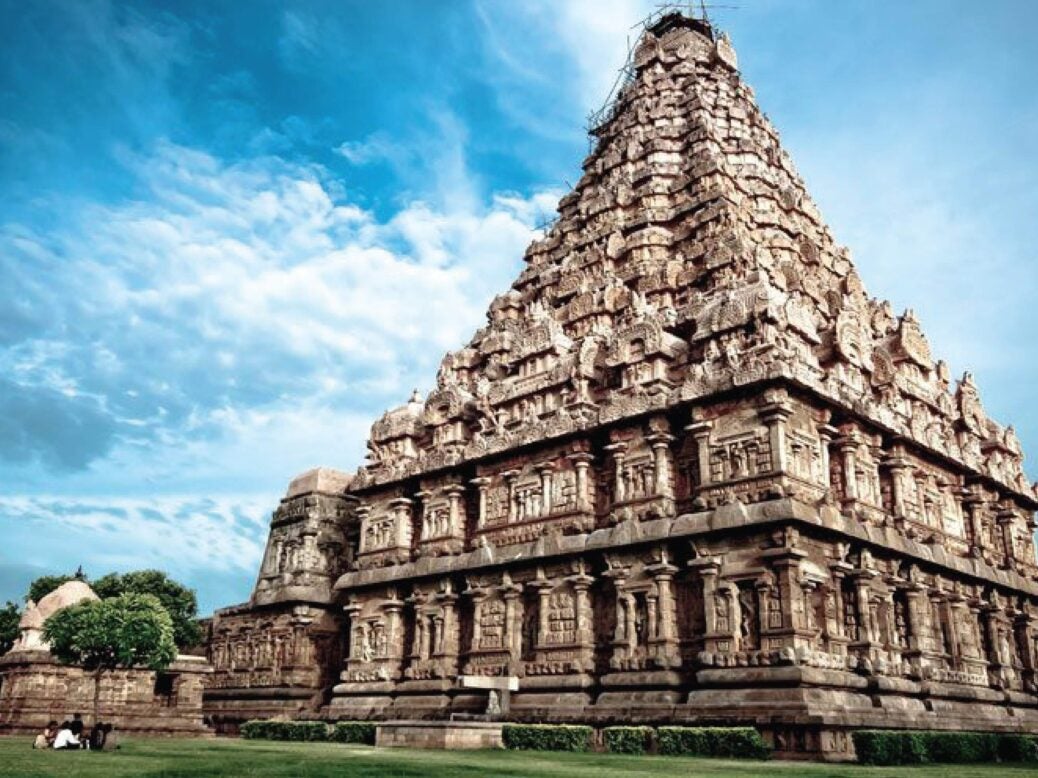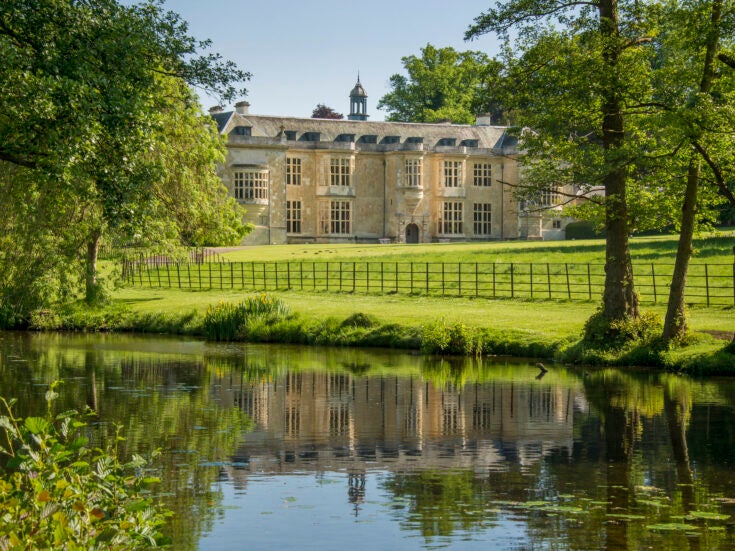
Tamil Nadu flies under the tourist radar, but it shouldn’t — this sleepy corner of India is a treasure trove, writes Andrew Harris
No wonder they all seem so contented. The outsider looking in at rural Tamil Nadu could be excused for concluding that life is one big long festival. This particular one, winding along the dusty lane of a remote village, is definitely of the makeshift variety, tractors hauling tinsel-adorned floats bearing garlanded gods sat next to crackling speakers blasting out more crackle than speak.
One float is being pulled along by a young man, not by ropes but butchers’ hooks inserted into his back, and for good measure there’s an enormous spear piercing both cheeks of his face as if an unfortunate by-product of the village athletics team’s javelin practice. Dangling over the front of the next float is a man suspended by the same butcher’s hooks dug deep into the distended skin of his back and legs. He wears nothing apart from a bright red loin cloth, a big yellow flower on his forehead and a huge smile whenever he’s pushed back and forth like a giant human swing. You don’t see that every day do you?
However, I was supposed to be looking at temples.
At the world-famous Karnak temple in southern Egypt, a competent Egyptologist should be able to bring the ancient stones back to some sort of life for you. They might reinstate gigantic cedar of Lebanon doors, replace the collapsed roof and repaint loud colours long since weathered away into a stony magnolia that ancient Egyptians definitely didn’t use for interior decoration. Putting yourself through the Cecil B DeMille of the sound-and-light show could even add a little brushwork to any such picture of what it was really like in there.
However, at the not especially famous Chidambaram temple in southern India, where sound and light shows are probably still some way off given that I was the only tourist there, such mental exertions aren’t required, as you now have a ringside seat at the sort of jaw-dropping spectacle of ancient religious devotion that your Egyptologist could never have served up. Barefoot devotees pad across stone slabs worn down by centuries of meandering through never-ending dark passageways in a labyrinthine world of shrines and complex rituals executed by elaborately adorned priests, of fire and flowers and hypnotic chanting of vedas echoing around statues of gods whose names and spheres of influence you can only guess at. A nonstop spiritual tasting menu served at a table you weren’t actually invited to but nobody’s asking you to leave, a breathtaking sensory drama that can’t be re-created because it was never destroyed in the first place. Welcome to the Hindu heartland of Tamil Nadu, the only surviving classical civilisation in the world (according to Professor Michael Wood of BBC4 fame). Welcome to temple country.
While Rajasthan has palaces, Goa its palm-fringed beaches, and Kerala its backwater retreats, less-travelled Tamil Nadu, in India’s south-east, has temples — around 34,000 of them, give or take a temple. The other main attraction is Kollywood, the prolific Tamil film industry (named after the Chennai suburb Kodambakkam), with its own pantheon of earthly deities. One half expects to encounter ‘Indiana Gupta and the Tamil Temple of Doom’, although he would in any event be eclipsed by the recently deceased chief minister of Tamil Nadu, Jayalalithaa, a former studio starlet, not to mention her on-screen partner, the late MG Ramachandran (MGR to you and me), whose statue, complete with black-painted film star shades, is in almost every village, he having also served three terms as chief minister.
Jayalalithaa, who died in December, had begun her sixth term in May 2016, exonerated from a brief 2014 incarceration, following which three people hanged themselves, one jumped under a bus, two self-immolated, another took poison, ten died of cardiac arrest, and one cut off their finger. Drama? When it has a mind to, the deep south of India can make the Godfather trilogy look like Lassie Come Home.
Jayalalithaa, who had such disparate claims to fame as hosting the world’s largest wedding banquet (for 150,000 guests at her stepson’s wedding in 1995) to progressive innovations such as police stations operated by and only for women, remains an enduring figurehead for this forgotten but fabulous corner of India. As new India’s tectonic plates rupture relentlessly with the old, there remains in Tamil Nadu a universe of restrained serenity, a red, rich and ancient cultural landscape peopled by a quiet dignity, and of course those temples.
A different atmosphere prevails from that in the north, where Muslim empires ruled over large tracts of India, embedding pockets of Islamic culture in their wake. One wonders if the sheer complexity, scale and logistics of the subcontinent (not least the number of people) somehow confounded the armies of monotheism as they ventured south, any intentions to put recalcitrant potential converts to the sword perhaps compromised by not bringing enough swords! The overriding impression is one of Hindu hegemony and probably explains why you’d be 2,000km north in Agra marvelling at the Taj Mahal, and not in Thanjavur, ancient capital of the south.
Thanjavur… gentle custodian of Tamilian treasures, whiling away the centuries in splendid isolation on an offshoot of the sacred Cauvery river, the ‘Ganges of the South’. This former nerve centre of a once mighty dynasty may not be able to deliver up the Taj Mahal, the main wonder of the world here being to wonder why so few travellers make it to the incredible Brihadeshwara temple towering above the town. Completed a thousand years ago and listed by Unesco along with two others nearby as ‘The Great Living Chola Temples’, its spellbinding artistry remains in a remarkable state of preservation.
Thanjavur is also the location for one of the most exciting debuts into the South Indian hospitality nexus in recent times, with the opening of Svatma, not far from the temple. Svatma, ‘one’s own soul’, is the carefully curated brainchild of Krithika Subramanian, a designer and architect who has presented a beautifully crafted boutique hotel with impeccable style credentials alloyed with a laudable ambition of promoting Tamil culture. Hence Thanjavur, a town forever intertwined with Tamil art and history, from the bronze casting for which the Chola empire was famous to Bharatanatyam, the classical dance form still performed inside the temple compound. Krithika, a Bharatanatyam dancer herself, is clearly deeply immersed in her heritage and while Hinduism doesn’t normally impress as a proselytising faith, the desire to educate and elucidate the myriad underpinnings of this ancient belief is palpable.
The hotel, whose open and airy tropical entrance immediately invites comparison with the better boltholes of Ubud in Bali, is an accomplished amalgamation of a restored hundred-year-old mansion containing five rooms and two suites with a new build block of 31 further rooms, none identical. The lovely walled swimming pool which like so much here incorporates delightful design detail, recalled swimming in the Maharajah of Jaipur’s former pool in Samode, Rajasthan, which was also enclosed in a similar manner. If it was good enough for him…
There’s a colonial style banqueting hall, a luxuriously appointed spa, gym and yoga centre and three dining options, the main restaurant Aaharam being a gorgeously conceived homage to the highest aspirations of South India’s vegetarian traditions. If ever a spell of gastronomic indulgence away from anything involving an abattoir was on the cards, it would be difficult to imagine a better venue than this to begin. The effusively friendly restaurant manager is always keen to explain and to elaborate, actually setting up a huge platter of the vegetables used in the kitchen, next to our table.
A section of the restaurant is used for cookery classes, just one of several opportunities enthusiastically extended towards guests to get up close and personal with local culture, from concerts of classical Carnatic music, lecture demonstrations from Bharatanatyam dancers, Thanjavur painting classes, and academics available for temple trips.
Tanjore, as Thanjavur is also known, is ideally located to make such cultural sorties, foraying through forgotten villages spread out across Tamil Nadu like a giant rice paddy welcome mat to the laid-back rhythms of rural life. There’s heat and dust, of course, but also pride amid poverty, people from all walks of life here disporting a genuinely friendly and self-effacing approach to the world within which you can only feel at ease.
Aside from being well positioned for visiting other southern areas of interest, a veritable treasure trove of temples lies within striking distance of Svatma, from those Unesco sites to ones devoured daily by hordes of Hindu pilgrims. There are temples where non-Hindus are forbidden, but in the main this isn’t an issue (yet!). In any event, if I was them I’m not sure I would want me in my temple either.
A telltale sign that you’re nearing a place of worship can often be the prevalence of bald people. The ritual shaving of heads, tonsuring, in acts of religious devotion is widespread at temples and shrines across south India, with the highly prized women’s hair commercialised into extensions destined for the heads of Western women, not least the Afro-Caribbean community. The women who donate it seem to have little interest in where it ends up, while women spending serious money on it in Brixton or Brooklyn often believe it to be from Brazil, Peru, Mongolia or Malaysia. There is, however, only one place where huge numbers of women stand under a blazing sun for hours on end only to witness their cherished tresses cascading to the floor, for no monetary recompense. As for all these shaven heads implying ill-health, the undisputed high quality of this hair is more likely a validation of thousands of years of continuous vegetarianism.
Back at boutique hotel base camp, I have ended up in Svatma’s peaceful rooftop bar, silently succumbing to a soporific tranquillity tiptoeing across the Tanjore skyline, the full moon so incredibly luminescent, they’ve obviously had the painters in while I was out, shining like a Kollywood studio floodlight onto multi-coloured low-rise rooftops. The headlights of a local bus zigzag lazily down a distant hill like two drops of rain down a pane before being swallowed back into the night, the all-consuming stillness punctuated only by strains of a Tamil musical wailing into the warmth. There’s no evidence of a festival, so they clearly do have a night off now and then, although this timeless Thanjavur film-set looks like it’s about to call it a wrap. Weakened by something labelled ‘Kingfisher Strong’ (indeed, it was), I felt it was time to slide off my panoramic perch and follow suit.
Svatma, meanwhile, assumes the allure of a luxuriously appointed island, adrift in a sun-drenched sea of sumptuous spirituality, and so with ‘Incredible India’ transforming at an incredible pace you should set sail for it sooner rather than later.
Double rooms at Svatma, a Relais & Chateaux property, are from £170 p.n. inc. breakfast, ex. taxes. Jet Airways flies daily from Heathrow to India, and has the largest Indian domestic network: London to Chennai from £1,819 in Premiere (business), and £3,185 in First.






